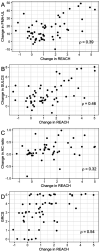Responsiveness and trajectory of changes in the rating of everyday arm-use in the community and home (REACH) scale over the first-year post-stroke
- PMID: 36310441
- PMCID: PMC9989222
- DOI: 10.1177/02692155221134413
Responsiveness and trajectory of changes in the rating of everyday arm-use in the community and home (REACH) scale over the first-year post-stroke
Abstract
Objective: To examine the trajectory of the Rating of Everyday Arm-use in the Community and Home (REACH) scores over the first-year post-stroke, determine if REACH scores are modified by baseline impairment level and explore the responsiveness of the REACH scale through hypothesis testing.
Design: Consecutive sample longitudinal study.
Setting: Participants were recruited from an acute stroke unit and followed up at three, six, and 12 months post-stroke.
Participants: Seventy-three participants with upper limb weakness (Shoulder Abduction and Finger Extension score ≤ 8).
Main measures: The REACH scale is a six-level self-report classification scale that captures how the affected upper limb is being used in one's own environment. The Fugl-Meyer Upper Limb Assessment (FMA-UL), Stroke Upper Limb Capacity Scale (SULCS), accelerometer-based activity count ratio and Global Rating of Change Scale (GRCS) were used to capture upper limb impairment, capacity, and use.
Results: The following proportions of participants improved at least one REACH level: 64% from baseline to three months, 37% from three to six months and 13% from six to 12 months post-stroke. The trajectory of REACH scores over time was associated with baseline impairment. Change in REACH had a moderate correlation to change in SULCS and the GRCS but not FMA-UL or the activity count ratio.
Conclusions: Results of hypothesis testing provide preliminary evidence of the responsiveness of the REACH scale. On average, individuals with severe impairment continued to show improvement in use over the first year, while those with mild/moderate impairment plateaued and a small proportion decreased in the early chronic phase.
Keywords: Stroke; longitudinal study; responsiveness; upper limb use.
Conflict of interest statement
The authors declared no potential conflicts of interest with respect to the research, authorship, and/or publication of this article.
Figures



Similar articles
-
Convergent Validity and Responsiveness of the SULCS.Arch Phys Med Rehabil. 2019 Jan;100(1):140-143.e1. doi: 10.1016/j.apmr.2018.07.433. Epub 2018 Aug 24. Arch Phys Med Rehabil. 2019. PMID: 30148996 Free PMC article.
-
Prognosis prediction of the effect of botulinum toxin therapy and intensive rehabilitation on the upper arm function in post-stroke patients using hierarchical cluster analysis.Disabil Rehabil. 2022 Nov;44(22):6815-6823. doi: 10.1080/09638288.2021.1977394. Epub 2021 Sep 21. Disabil Rehabil. 2022. PMID: 34547217 Clinical Trial.
-
Comparison of the action research arm test and the Fugl-Meyer assessment as measures of upper-extremity motor weakness after stroke.Arch Phys Med Rehabil. 2006 Jul;87(7):962-6. doi: 10.1016/j.apmr.2006.02.036. Arch Phys Med Rehabil. 2006. PMID: 16813784
-
Comparing upper limb motor recovery in subacute ischaemic stroke and intracerebral haemorrhage: A Systematic Review.Health Open Res. 2025 May 6;5:33. doi: 10.12688/healthopenres.13450.2. eCollection 2023. Health Open Res. 2025. PMID: 40469925 Free PMC article.
-
Effects of Robot-Assisted Therapy for the Upper Limb After Stroke.Neurorehabil Neural Repair. 2017 Feb;31(2):107-121. doi: 10.1177/1545968316666957. Epub 2016 Sep 24. Neurorehabil Neural Repair. 2017. PMID: 27597165 Review.
Cited by
-
A Randomized Control Trial of a Virtually Delivered Program for Increasing Upper Limb Activity After Stroke.Neurorehabil Neural Repair. 2025 Mar;39(3):179-189. doi: 10.1177/15459683241303702. Epub 2024 Dec 27. Neurorehabil Neural Repair. 2025. PMID: 39727287 Free PMC article. Clinical Trial.
References
-
- Assadi SH, Gross-Nevo RF, Dudkiewicz I, et al. Improvement of the upper extremity at the subacute stage poststroke: does hand dominance play a role? Neurorehabil Neural Repair 2020; 34: 1030–1037. - PubMed
-
- Bernhardt J, Hayward KS, Kwakkel G, et al. Agreed definitions and a shared vision for new standards in stroke recovery research: the stroke recovery and rehabilitation roundtable taskforce. Neurorehabil Neural Repair 2017; 31: 793–799. - PubMed
-
- Borschmann KN, Hayward KS. Recovery of upper limb function is greatest early after stroke but does continue to improve during the chronic phase: a two-year observational study. Physiotherapy 2020; 107: 216–223. - PubMed
MeSH terms
LinkOut - more resources
Full Text Sources
Medical

